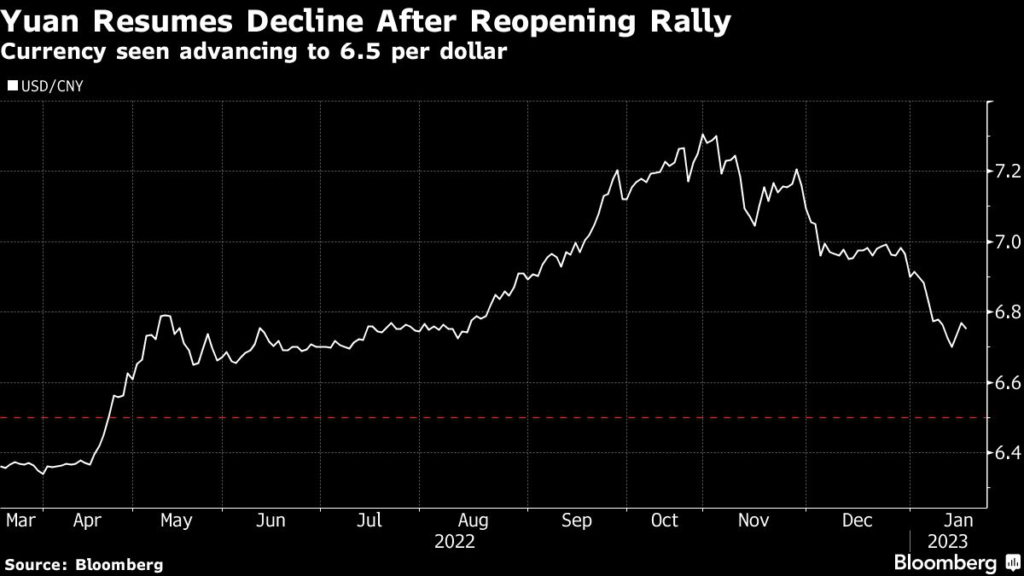China’s yuan is poised to resume its advance as the removal of Covid curbs supercharges economic recovery in 2023, according to a veteran trader at Standard Chartered Plc.
(Bloomberg) — China’s yuan is poised to resume its advance as the removal of Covid curbs supercharges economic recovery in 2023, according to a veteran trader at Standard Chartered Plc.
“The yuan is more likely to go to 6.5 per dollar than to 7 within the next three to six months,” said Charles Feng, head of macro trading for Greater China & North Asia at Standard Chartered in Hong Kong. For those global investors who are still heavily underweight yuan assets and exporters who own a sizable amount of dollars, “there’s a lot of catch-up to do”, he said.
The yuan rallied 8% from a 15-year low in November, buoyed by China’s swift dismantling of Covid curbs before stalling at around the 6.8-per-dollar level. That’s likely because dollar sales by exporters for payments before the Lunar New Year eased and concerns grew that a resumption of outbound travel would spur outflows.
However, Feng expects downside risks for the yuan to be contained.
Outbound tourism and overseas spending won’t be major obstacles for the yuan’s gains, Feng said, adding that he only expects travel to surge when income and jobs are satisfying. He also expects stronger sentiment toward yuan assets following the reopening to offset headwinds from a potential worsening of the balance of payments.
Feng’s optimism toward the yuan is echoed by strategists at HSBC Bank Plc and Commerzbank AG, who’ve lifted their year-end forecast for the currency this week to 6.5 per dollar. Goldman Sachs Group Inc. this month predicted the yuan advancing to that mark, which would imply a gain of around 4% from current levels.
To be sure, there may be bumps in the road short-term, Stephen Chiu, Chief Asia FX and rates strategist at Bloomberg Intelligence wrote in a note. “Caution may be required as China’s macro data would have to back the optimism.”
However in the medium term, “a more sustainable dollar decline could aid the yuan, especially when the Fed reverts to an easing cycle,” wrote Chiu.
Bond Flows
Better growth and allocation to riskier assets may push China’s 10-year government bond yield to above 3%, but Feng expects the topside to be capped. He’s optimistic about global demand for China bonds in the medium- to long-term, due to yuan gains, a decline in population, slower urbanization, and likely subdued demand for credit from the property sector. Geopolitical tensions may not be worse than in 2022, he added.
Developed-market bonds may perform better this year on a possible Federal Reserve policy pivot, Feng said. Still Chinese bonds’ outperformance versus developed-market peers in the past two years makes it hard to ignore this asset class for diversification, Feng said. Chinese government bonds posted a loss of 5.2% last year after a gain of 8.7% in the previous year in dollar terms, total return data on Bloomberg China Aggregate Treasury Index show.
Inflows into China bonds resumed in December and extended in the first half of January, according to a spokesperson at the FX regulatory body. China last year recorded its first annual outflow from its onshore bond market since the nation started reporting the holdings data in 2014.
Efforts from Chinese regulators to allow foreign banks to trade local sovereign bond futures, provision of access to onshore interest-rate derivatives market and the possible establishment of China government bond futures in Hong Kong will improve investor interest in Chinese debt by allowing them to hedge positions in the cash bond market.
The environment is more conducive now for more market opening measures after a volatile 2022, he said.
Feng started his career in the financial markets with Salomon Brothers as a fixed-income research analyst in 1995 in New York before returning to Asia in 2002 to be the head of China interest-rates trading for Deutsche Bank AG based in Hong Kong and Shanghai. He joined Standard Chartered in 2009.
–With assistance from Colleen Goko.
(Updates with analysts comment in fifth paragraph after Chart)
More stories like this are available on bloomberg.com
©2023 Bloomberg L.P.










